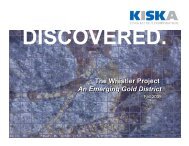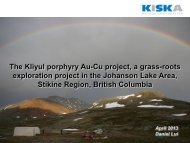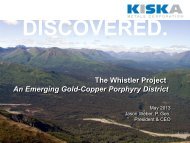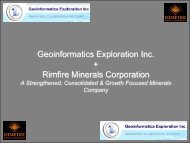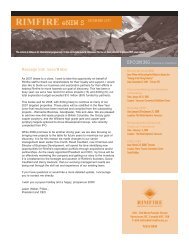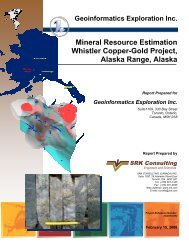view FS - Kiska Metals Corporation
view FS - Kiska Metals Corporation
view FS - Kiska Metals Corporation
You also want an ePaper? Increase the reach of your titles
YUMPU automatically turns print PDFs into web optimized ePapers that Google loves.
<strong>Kiska</strong> <strong>Metals</strong> <strong>Corporation</strong><br />
Notes to the consolidated interim financial statements<br />
March 31, 2012 and 2011<br />
(Expressed in Canadian Dollars)<br />
(Unaudited – Prepared by Management)<br />
4. Summary of significant accounting policies (continued)<br />
Restricted cash<br />
Restricted cash consists of term deposits in favor of regulatory authorities held as site restoration<br />
deposits or performance bonds for mineral properties.<br />
Interests in joint ventures (Note 6)<br />
Reimbursement of the joint venture operator’s costs<br />
When <strong>Kiska</strong>, acting as an operator, receives reimbursement of direct costs recharged to the joint venture,<br />
such recharges represent reimbursements of costs that the operator incurred as an agent for the joint<br />
venture and therefore have no effect on profit or loss.<br />
In some cases, <strong>Kiska</strong> also incurs certain general overhead expenses in carrying out activities on behalf of<br />
the joint venture. As these costs can often not be specifically identified, joint venture agreements allow<br />
the operator to recover the general overhead expenses incurred by charging a project management fee<br />
that is based on a fixed percentage of the total costs incurred for the year. Although the purpose of this<br />
recharge is very similar to the reimbursement of direct costs, <strong>Kiska</strong> is not acting as an agent in this case.<br />
Therefore, the general overhead expenses and the project management fee are recognized in profit or<br />
loss as an expense and income respectively.<br />
Jointly controlled assets<br />
A jointly controlled asset involves joint control and offers joint ownership by the Group and other<br />
venturers of assets contributed to or acquired for the purpose of the joint venture, without the formation of<br />
a corporation, partnership or other entity.<br />
Where the Group’s activities are conducted through jointly controlled assets, the Group recognizes its<br />
share of the jointly controlled assets, and liabilities it has incurred, its share of liabilities incurred jointly<br />
with other venturers, related revenue and operating costs in the financial statements and a share of their<br />
production.<br />
Investments in associates<br />
Associates are those entities over which the Group is able to exert significant influence but which are<br />
neither subsidiaries nor joint ventures. Investments in associates are initially recognized at cost and<br />
subsequently accounted for using the equity method. Any goodwill or fair value adjustment attributable to<br />
the Group's share in the associate is included in the amount recognized as investment in associates.<br />
The carrying amount of the investments in associates is increased or decreased to recognize the Group’s<br />
share of the profit or loss and other comprehensive income of the associate. These changes include<br />
subsequent depreciation, amortization or impairment of the fair value adjustments of assets and liabilities.<br />
Unrealized gains and losses on transactions between the Group and its associates are eliminated to the<br />
extent of the Group's interest in those entities. Where unrealized losses are eliminated, the underlying<br />
asset is also tested for impairment.<br />
Amounts reported in the financial statements of associates have been adjusted where necessary to<br />
ensure consistency with the accounting policies of the Group.<br />
9



